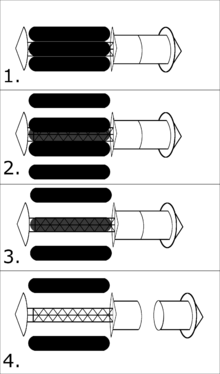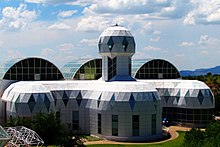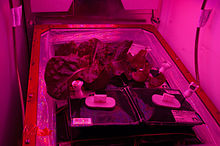Several space exploration missions are scheduled to occur in the future. The purpose of most of these missions is to launch spacecraft into space, providing information on nearby planets, asteroids, and other features in outer-space. In addition, astronomers are trying to figure out ways to make manned space exploration possible for large amounts of time, so that humans may be able to safely travel far away from Earth in the future.
Missions
Mars
Mars 2020 rover
The Mars 2020 rover, part of NASA’s Mars Exploration Program, is scheduled to launch in July/August 2020.[1] This mission will collect samples for future return to Earth to provide insight on the possibility of life on Mars. It will seek for signs of past microbial life and habitable conditions while also collecting information on resources for future astronauts.The Mars 2020 rover will collect core samples and put them in a cache for future missions to retrieve for testing. Furthermore, the rover will test a method for producing oxygen from the atmosphere on Mars, characterize environmental conditions, and identify other resources for future astronauts.[1]InSight
Interior Exploration using Seismic Investigations, Geodesy and Heat Transport (InSight), part of NASA’s Discovery Program, is scheduled to launch in May 2018. It plans to study Mars’ interior to investigate the history of the evolution of this planet to provide insight on the evolutionary processes of all the rocky planets in the inner solar system.[2] Since Mars is less geologically active, it has more extensive signs of early terrestrial planet formation. The data collected will help scientists understand Mars’ history, which will provide information on the forces that shaped Earth.Asteroids
An article in science magazine Nature suggested the use of asteroids as a gateway for space exploration, with the ultimate destination being Mars. In order to make such an approach viable, three requirements need to be fulfilled: first, "a thorough asteroid survey to find thousands of nearby bodies suitable for astronauts to visit"; second, "extending flight duration and distance capability to ever-increasing ranges out to Mars"; and finally, "developing better robotic vehicles and tools to enable astronauts to explore an asteroid regardless of its size, shape or spin." Furthermore, using asteroids would provide astronauts with protection from galactic cosmic rays, with mission crews being able to land on them without great risk to radiation exposure.
The spacecraft’s path (green) is shown in a frame of reference where
Jupiter remains stationary. Lucy has two close Earth flybys before
encountering its Trojan targets. After 2033, Lucy will continue cycling
between the two Trojan clouds every six years.
Lucy
Lucy, part of NASA's Discovery Program, is scheduled to launch in October 2021 to explore six Trojan Asteroids and a Main Belt asteroid. The two Trojan swarms ahead of and behind Jupiter are thought to be dark bodies made of the same material as the outer planets that were pulled into orbit near Jupiter.[3] Lucy will be the first mission to study the Trojans, and scientists hope the findings from this mission will revolutionize our knowledge of the formation of the solar system. For this reason, the project is named after Lucy, a fossilized hominid that provided insight on the evolution of humans. The asteroids studied are ancient fossils of planet formation which could hold clues to the origins of life on Earth.[4]Psyche
The Psyche spacecraft, part of NASA's Discovery Program, is scheduled to launch at the end of 2022 to 16 Psyche, a metallic object in the asteroid belt.[5] 16 Psyche is 130 miles (210 km) wide, and it is made almost entirely of iron and nickel instead of ice and rock. Because of this unique composition, scientists believe it is the remnants of a planet’s core that lost its exterior through a series of collisions, but it is possible that 16 Psyche is only unmelted material.[3] NASA hopes to obtain information about planetary formation from directly studying the exposed interior of a planetary body, which would otherwise not be possible.[6]OSIRIS-REx
The Origins Spectral Interpretation Resource Identification Security - Regolith Explorer (OSIRIS-REx) spacecraft was launched on September 8, 2016.[7] It will travel to 1999 RQ36 (Bennu) to collect samples of this asteroid because it is believed to be relatively unchanged. Bennu is largely made up of chondrules, clumps of molten rock held together by electrostatic and gravitational forces, that have not been altered geologic activity or other reactions, making it a prime example of the early solar system.[8]Deep space
TESS
The Transiting Exoplanet Survey Satellite (TESS) was launched on April 18, 2018[9] and will search for exoplanets using the transit method. This mission is scheduled to run for two years, and will focus on 200,000 stars near our solar system to find orbiting exoplanets. TESS is on a larger scale than missions before as it will study brighter stars and cover more sky area than the 2013 Kepler mission did.[10]
Artist Concept of the James Webb Space Telescope
James Webb Space Telescope
The James Webb Space Telescope (JWST) is scheduled to launch in May, 2020 as a collaboration between NASA, the European Space Agency (ESA), and the Canadian Space Agency (CSA).[11][12] It is an infrared telescope with a 6.5-meter primary mirror that will serve as the premier observatory of the next decade. It will study the phases of the Universe, providing detailed information on the formation of solar systems and the evolution of space.[13]Limitations with deep space exploration
The future possibilities for deep space exploration are currently held back by a set of technical, practical, astronomical, and human limitations, which define the future of manned and unmanned space exploration. As of 2017, the farthest any man-made probe has traveled is the current NASA mission Voyager 1,[14] currently about 13 billion miles (21 billion km), or 19.5 light hours away from the Earth, while the nearest star is around 4.24 light years away.Technical limitations
The current status of space-faring technology, including propulsion systems, navigation, resources and storage all present limitations to the development of human space exploration in the near future.Distances
The astronomical order of magnitude of the distance between us and the nearest stars is a challenge for the current development of space exploration. At our current top speed of 157,100 miles per hour (70.2 km/s), the Helios 2 probe would arrive at the nearest star, Proxima Centauri, in around 18,000 years,[15] much longer than a human lifespan.Propulsion and fuel
The VASIMR Plasma based propulsion engine[16]
In terms of propulsion, the main challenge is the liftoff and initial momentum, since there is no friction in the vacuum of space. Based on the missions goals, including factors such as distance, load and time of flight, the type of propulsion drive used, planned to use, or in design varies from chemical propellants, such as liquid hydrogen and oxidizer[17] (Space Shuttle Main Engine), to plasma[16] or even nanoparticle propellants.[18]
Project Longshot Nuclear Fission Engine schematic
As for future developments, the theoretical possibilities of nuclear based propulsion have been analyzed over 60 years ago, such as nuclear fusion (Project Daedalus) and nuclear pulse propulsion (Project Longshot),[19] but have since been discontinued from practical research by NASA. On the more science fiction side, the theoretical Alcubierre drive presents a mathematical solution for “faster-than-light” travel, but it would require the mass-Energy of Jupiter, not to mention the technical issues.[20]
Human limitations
The human part of manned space exploration add certain physiological and psychological issues and limitations to the future possibilities of space exploration, along with the need for storage and supply of sustenance.Physiological issues
The transitioning gravity magnitudes on the body is detrimental to orientation, coordination, and balance. Without constant gravity, bones suffer disuse osteoporosis, and their mineral density falls 12 times faster than the average elderly adult’s.[21] Without regular exercise and nourishment, there can be cardiovascular deterioration and loss in muscle strength.[22] Dehydration can cause kidney stones,[23] and constant hydro-static potential in zero-g can shift body fluids upwards and cause vision problems.[24]Furthermore, without Earth’s surrounding magnetic field, solar radiation has much harsher effects in space. The exposure can include damage to the central nervous system (altered cognitive function, reduced motor function, and behavioral changes) and degenerative tissue diseases.
Psychological issues
The Biosphere 2 greenhouse habitat
According to NASA, isolation in space can have detrimental effects on the human psyche. Behavioral issues, such as low morale, mood-swings, depression, and decreasing interpersonal interactions, irregular sleeping rhythms, and fatigue occur independently to the level of training, according to a set of NASA's social experiments.[25] The most famous of which, Biosphere 2,[26] was a 2 year long, 8 person crew experiment in the 1990s, in an attempt to study human necessities and survival in an isolated environment. The result of which were stressed interpersonal interactions and aloof behavior, including limiting and even ceasing contact between crew members,[25] along with failing to sustain a lasting air-recycling system and food supply.[27]
Resources and sustenance
Considering the future possibility of extended, manned missions, food storage and resupply are relevant limitations. From a storage point of view, NASA estimates a 3-year Mars mission would require around 24 thousand pounds (10,000 kg) of food, most of it in the form of precooked, dehydrated meals of about 1.5 pounds a portion.[28] Fresh produce would only be available in the beginning of the flight, since there would not be refrigeration systems. Water's relative heavy weight is a limitation, so on the International Space Station (ISS) the use of water per person is limited to 11 liters a day, compared to the average Americans' 132 liters.[28]
The ISS "Veggie plant growth system" and Red Romaine Lettuce
As for resupply, efforts have been made to recycle, reuse and produce, to make storage more efficient. Water can be produced through chemical reactions of Hydrogen and Oxygen in fuel cells,[28] and attempts and methods of growing vegetables in micro-gravity are being developed and will continue to be researched. Lettuce has already successfully grown in the ISS's "Veggie plant growth system", and has been consumed by the astronauts, even though large-scale plantation is still impractical,[29] due to factors such as pollination, long growth periods, and lack of efficient planting pillows.
Artificial Intelligence and Robotic Space Craft Development
The idea of using high level automated systems for space missions has become a desirable goal to space agencies all around the world. Such systems are believed to yield benefits such as lower cost, less human oversight, and ability to explore deeper in space which is usually restricted by long communications with human controllers. Autonomy will be a key technology for the future exploration of our solar system, where robotic spacecraft will often be out of communication with their human controllers.Autonomous systems
Autonomy is defined by three requirements:- The ability to make and carry out decisions on their own, based on information on what they sensed from the world and their current state.
- The ability to interpret the given goal as a list of actions to take.
- The ability to fail flexibly, meaning they are able to continuously change their actions based on what is happening within their system and their surrounding.
NASA's autonomous science experiment
NASA began its autonomous science experiment (ASE) on Earth Observing-1 (EO-1), which is NASA's first satellite in the millennium program, Earth-observing series launched on November 21, 2000. The autonomy of these satellites is capable of on-board science analysis, re-planning, robust execution, and model-based diagnostic. Images obtained by the EO-1 are analyzed on-board and down linked when a change or interesting event occurs. The ASE software has successfully provided over 10,000 science images. This experiment was the start of many that NASA devised for AI to impact the future of space exploration.Artificial Intelligence Flight Adviser
NASA's goal with this project is to develop a system that can aid pilots by giving them real-time expert advice in situations that pilot training does not cover or just aid with a pilot's train of thought during flight. Based on the IBM Watson cognitive computing system, the AI Flight Adviser pulls data from a large database of relevant information like aircraft manuals, accident reports, and close-call reports to give advice to pilots. In the future, NASA wants to implement this technology to create fully autonomous systems, which can then be used for space exploration. In this case, cognitive systems will serve as the basis, and the autonomous system will completely decide on the course of action of the mission, even during unforeseen situations.[31] However, in order for this to happen, there are still many supporting technologies required.In the future, NASA hopes to use this technology not only in flights on earth, but for future space exploration. Essentially, NASA plans to modify this AI flight Advisor for Longer range applications. In addition to what the technology is now, there will be additional cognitive computing systems that can decide on the right set of actions based upon unforeseen problems in space. However, in order for this to be possible, there are still many supporting technologies that need to be enhanced.





